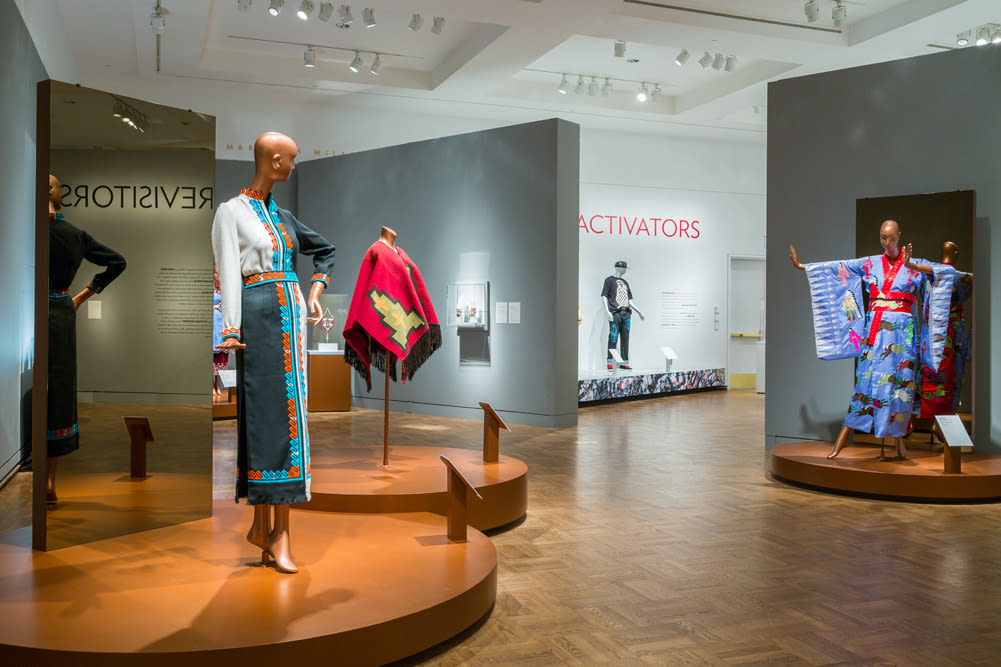Native Fashion Now at the Portland Art Museum

Phillip Hillaire on Portland Art Museum’s Native Fashion Now
As if taking a cue from the “Desert Heat” banners on the front of the Portland Art Museum featuring Native American designer Orlando Dugi, Portland was sizzling for the opening weekend of the hot summer exhibition Native Fashion Now.
From vibrant street clothing to exquisite haute couture, this exhibition celebrates the visual range, creative expression and political nuance of Native American fashion. Nearly 100 works from 71 designers, spanning the past half-century, explore the vitality of Native fashion designers and artists, from pioneering Native style-makers to today’s maverick designers making their mark in the fashion world.
While the exhibition was organized by the Peabody Essex Museum in Massachusetts, there has been tremendous support within the fashion and Native American community locally. As a member of the Portland Art Museum’s Native Art Advisory Board, Phillip Hillaire has played an integral role in building excitement, raising funds, and putting together an opening weekend Pop-Up Boutique on June 4 featuring 14 visiting artists. He also serves on the Regional Arts and Culture Council (RACC).
We asked Phillip to speak about his passion for this exhibition and his involvement in promoting Native American art.
How do you think Portlanders will respond to Native Fashion Now?
I think most visitors will be amazed with the blend of materials used for garments and jewelry. The stories that these designers share will also be a highlight because they are culturally chic designs from rich traditions, like the Dorothy Grant garments.
Another example is a Patricia Michaels dress. It has a blend of skyscraper shapes and falling rain pattern. I stood in the exhibit and told Patricia what I was seeing in her fabric, and I was pretty close to what she was trying to present in her work. Fascinating.
What has it been like working closely with the Museum and the featured designers?
It’s been really exciting to see and meet all the Native American designers who came into Portland for the opening weekend. Many of them I have followed over the years like Wendy Ponca, who I also admire for the work she has done with the American Indian College Fund (AICF).
Wendy designed an exclusive Pendleton blanket titled WAH-SHA-SHE for the AICF and I was able to place her blanket ads for the AICF to raise money for the tribal colleges. So, when I got a text from Wendy prior to the Pop-Up Boutique I was excited she was coming to Portland and that I was going to finally meet her in person after all these years.
Does your tribal affiliation influence your own clothing choices?
I am citizen of the Lummi Nation, Washington State, and yes, I too blend our traditional style into some of my modern style. I have a paddle shirt that was made by my dear cousin Kwetulghwolwit Loey. The men of the Lummi longhouses would wear their paddle shirts when dancing on the floor. The paddles on their shirts represented their accomplishments in their lives—the paddles were added to their shirts as they grew. They were referred to as warriors’ dance shirts. People today add paddles to their vests, dresses, and scarfs.
Were you familiar with the wide range of Native American fashion prior to being involved with this exhibition?
I have a lot of weavers in my family on both sides, and they have always inspired me to be creative while showcasing our culture. When I worked for the Smithsonian National Museum of the American Indian (NMAI) in Washington, D.C., I was exposed to a lot more traditional Native fashion, so I feel very fortunate to be able to say I know a lot about Native fashion.
What do you love about Native Fashion Now?
I look back before contact with Europeans came to our homelands and I see that we have always had fashion. We used many of our own traditional materials to make clothes and accessories. We had seashell beads, cedar wooden paddles, and we have always been weavers, weaving everything from cedar hats to blankets and leggings. Our people have always been fashionable, and today we incorporate new materials in with old materials.
Click here see a video of the Native Fashion exhibit or visit Portland Art Museum's website for more information!
